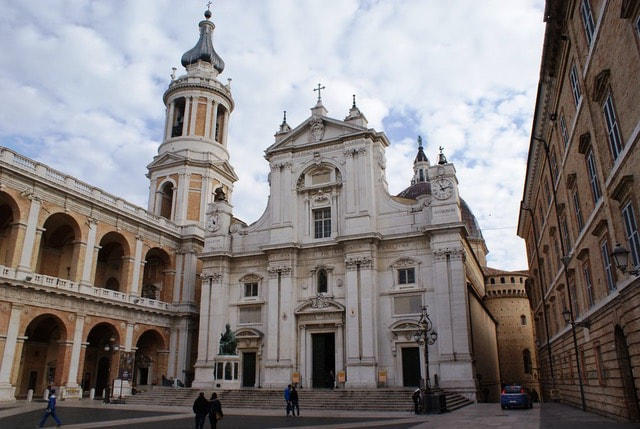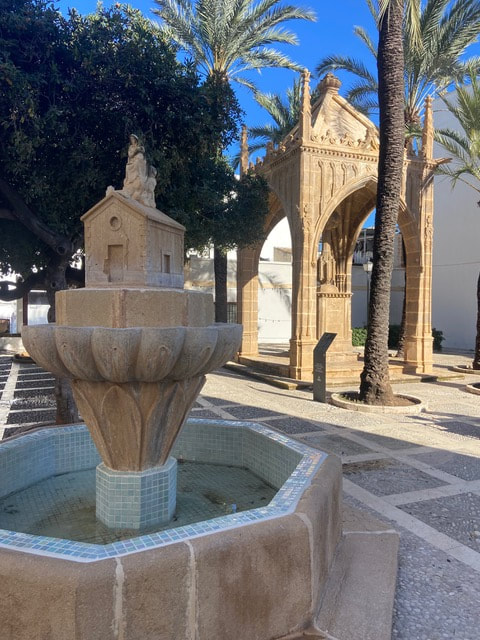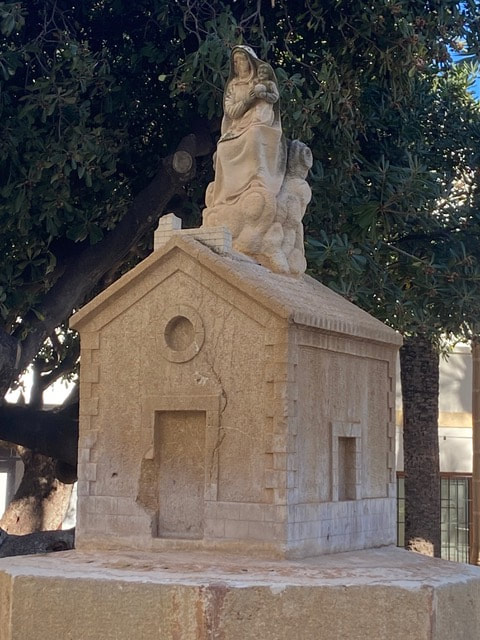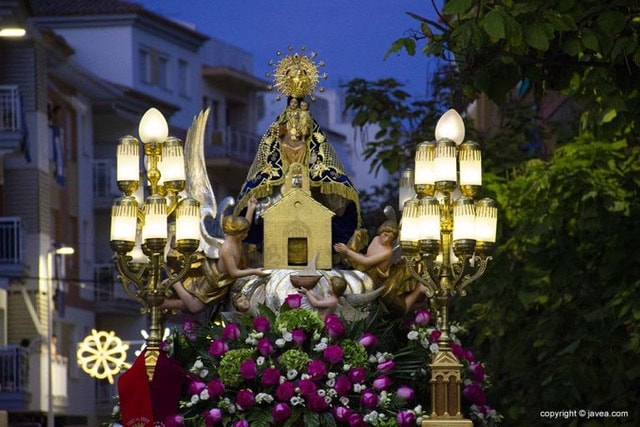|
To understand why this is so, one has to go back to the origins of the legend of the Santa Casa (the Holy House), the dwelling in Nazareth (Israel) where the Virgin Mary was born, where the Annunciation occurred, where Jesus lived until his 30th year, and where Joseph died. In the year 1291, when the Moslems definitively expelled the Crusader Knights from Palestine, legend has it that this house was miraculously transported by angels through the skies, first to Tersatto in Dalmatia (Croatia). Then a few years later in 1294, after a few other stops, it was put down by the angels in its final resting place, a laurel grove, (in Latin : lauretanum), from which Loreto is named, near Ancona, Italy. (Another story for the name was that the angels put the house down on the land of a noblewoman named Loreta). Here it stands to this day within the Basilica of the Holy House, one of the most visited Marian shrines in the world. A version which may be more plausible for us today, is that the wealthy Italian Angeli family had the Holy Family´s house disassembled to save it in the face of the Moslem invasion of 1291. They had it shipped to Italy via modern-day Croatia. The efforts of the Angelis turned into the legend that the angels had scooped up the holy abode. Science has proven that the house is in fact built with bricks that date back to the time of Christ and are of the same substance as other houses in Nazareth at that time. The „flight“ of the house and its long conservation explains why in 1920 the Virgin of Loreto was officially decreed the patroness of aeronautics and builders. So how come she became the patron saint of the fishermen of Xàbia ? Here too there is more than one legend. One popular story goes like this : in 1850 an Italian ship went aground off the coast of Cap Prim. Some fishermen went in their boats to save whom they could, but found only an icon of the Mare de Deu de Loreto to save. Another version is based on a document written in the 18th century. In March 1679 a skirmish between a Genovese ship called the „Virgen de Loreto“ and an armada of seven Turkish ships was seen by local fishermen off the coast of Xàbia. Miraculously, the Italian ship won the combat. This prompted the fisherman to pronounce the Virgin of Loreto as their patron saint. But in actual fact, we do not know when or why the fishermen of Xàbia chose the Virgen de Loreto as their patron saint. What we do know is that there was a chapel already dedicated to her in 1515 near the Puerta del Mar in the eastern part of the town, an area mainly inhabited by fishermen. However, we do not know whether she was revered by the inhabitants of Xàbia generally or whether the fishermen had already chosen her as their patron saint. A document of 1847 describes the chapel as rectangular with a large portico with 3 Mudejar-style naves, supported by 8 columns. The local school was also held here and there was an annex for the teacher´s quarters which was most probably added in 1556. We also know that in the 18th century some fishermen, who had died in a misfortune on the sea, were buried in this chapel. The chapel seems to have been renovated towards the end of the 18th century. Almost a century later it had again become so dilapidated that it was demolished after a major accident, where a part of the nave fell, killing one man. Today there is a public garden where the chapel stood. The only element that remainds us of the chapel is the „Jardinet de Loreto“, an edifice with a neo-Gothic style stone cross (1954), and the fountain decorated with a representation of the Holy Family´s House and a figure of the Virgin of Loreto carrying her son Jesus, built in 1923. This square is next to the Restaurant Trinquet and is called Plaza Vicent de Gràcia, in honour of the sandstone craftsman who made it. Since 1896 the fishermen´s annual fiestas in the Port are held in honour of their patron saint, Mare de Deu or Virgen de Loreto . These begin towards the end of August and end always on the 8th of September, the birthday of the Virgin Mary. (The official day of the Virgin of Loreto is celebrated in most countries on the 10th of December, the day when the Santa Casa arrived in Loreto) The fishermen´s new church, built in the mid 60s, is also dedicated to the Virgin of Loreto, but that is material for another article ……….
0 Comments
|
ACTIVITIES
Categories |
- Home
- Blogs
-
Projectes
- Premio de Investigación - Formularios de Inscripción
-
Traducciones Translations
>
-
DISPLAY PANELS - GROUND FLOOR
>
- THE STONE AGES - PALAEOLITHIC, EPIPALAEOLITHIC AND NEOLITHIC
- CAVE PAINTINGS (ARTE RUPESTRE)
- CHALCOLITHIC (Copper) & BRONZE AGES
- THE IBERIAN CULTURE (THE IRON AGE)
- THE IBERIAN TREASURE OF XÀBIA
- THE ROMAN SETTLEMENTS OF XÀBIA
- THE ROMAN SITE AT PUNTA DE L'ARENAL
- THE MUNTANYAR NECROPOLIS
- ARCHITECTURAL DECORATIONS OF THE PUNTA DE L'ARENAL
- THE ATZÚBIA SITE
- THE MINYANA SMITHY
- Translations archive
- Quaderns: Versión castellana >
- Quaderns: English versions >
-
DISPLAY PANELS - GROUND FLOOR
>
- Catálogo de castillos regionales >
- Exposició - Castells Andalusins >
- Exposición - Castillos Andalusíes >
- Exhibition - Islamic castles >
- Sylvia A. Schofield - Libros donados
- Mejorar la entrada/improve the entrance >
-
Historia y enlaces
-
Historía de Xàbia
>
- Els papers de l'arxiu, Xàbia / los papeles del archivo
- La Cova del Barranc del Migdia
- El Vell Cementeri de Xàbia
- El Torpedinament del Vapor Germanine
- El Saladar i les Salines
- La Telegrafía y la Casa de Cable
- Pescadores de Xàbia
- La Caseta de Biot
- Castell de la Granadella
- La Guerra Civil / the Spanish civil war >
- History of Xàbia (English articles) >
- Charlas y excursiones / talks and excursions >
- Investigacions del museu - Museum investigations
- Enllaços
- Enlaces
- Links
-
Historía de Xàbia
>
- Social media
- Visitas virtuales
- Tenda Tienda Shop







 RSS Feed
RSS Feed
